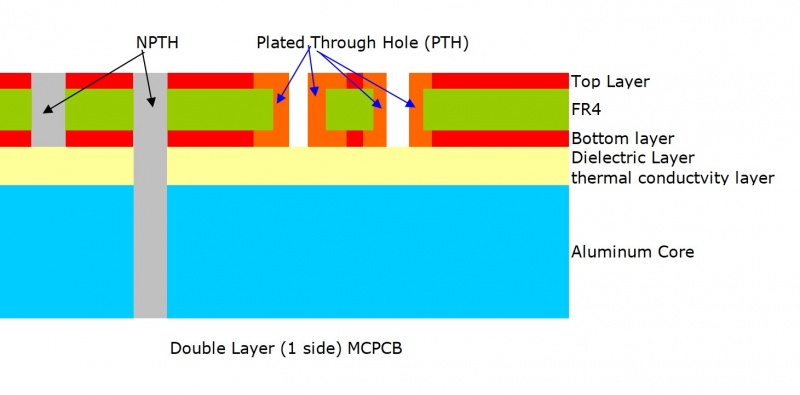What Is a Double-Sided Aluminum Core PCB?
- Views
- 31 Jan 2024
Just like single-layer metal core PCB, we can also do a two-layer metal core PCB. Two-layer metal core PCB consists of one aluminum or other metal base on the bottom side and two layers of copper conductor on the same side. Meanwhile, we can also say that two-layer metal core PCBs are composed of a single aluminum or other metal base (such as copper base) and a double-sided FR4 board. Due to that, there is only one copper circuit on the top, you only can SMD on the top side contrary to the double-side metal core PCB which has two sides to SMD.
comprehensive cost benefits
Relative to high-cost copper PCBs, metal core PCBs are generally more cost-effective, providing manufacturers with a more cost-effective solution and comprehensive cost benefits.
single-layer metal core PCB, Aluminum Base PCB, two-layer Aluminum Base PCB,
What is the biggest difference between the manufacturing of single-layer metal core PCB and two-layer metal core PCB? The answer is that we need to laminate the aluminum or other metal base (such as copper base) and the double-sided Fr4 board together to form a two-layer PCB.

Structure:
The structure of two layers of metal core PCBs includes:
1.Metal Core Layer (Bottom Side):
The bottom side of a two-layer metal core PCB is composed of a metal base, typically made of aluminum or other metals like copper.2.Thermal Conductivity Layer:
Sandwiched between the metal core layer and the FR4 layer is the thermal conductivity layer. This layer consists of a prepreg filled with high thermal conductivity and high insulation materials, serving the dual purpose of efficient heat dissipation and preventing electrical breakdown between electrodes.3.Bottom Circuit Layer:
Positioned directly on top of the metal core layer is the first circuit layer. This layer is made of electrolytic copper foil and undergoes an etching process to create the required circuit patterns. Unlike a double-sided metal core PCB that has two sides that could SMD, this side of the Bottom Circuit Layer could not SMD.4.FR4 Layer:
The top side of the two-layer metal core PCB features a double-sided FR4 board.5.Circuit Layer (Top Side):
On the top side of the FR4 layer is the second circuit layer. Similar to the bottom circuit layer, it is formed using electrolytic copper foil through an etching process. This circuit layer allows for SMD.Advantage:
As you see from the structure before, there are two copper layers. As a result, two-layer metal core PCBs have excellent conductivity, higher heat dissipation, and comprehensive cost benefits. Therefore, they provide more applications than a single layer.Excellent heat dissipation performance:
Compared with single-layer metal core PCB, double-layer metal core PCB has better heat dissipation performance and can efficiently conduct and dissipate the heat generated by electronic components. This helps keep electronic components working at low temperatures and improves equipment performance and lifespan.comprehensive cost benefits
Relative to high-cost copper PCBs, metal core PCBs are generally more cost-effective, providing manufacturers with a more cost-effective solution and comprehensive cost benefits.
Application:
UV LED (UV LED):
In UV LED applications, the double-layer metal core PCB can effectively dissipate heat and ensure that the equipment does not overheat during long-term work. It is suitable for fields such as UV curing.communication device:
Communication equipment such as 5G base stations have strict requirements for efficient heat dissipation. Double-layer metal core PCBs can be used to ensure the stability and reliability of this equipment when working at high power.Pool Lighting:
Double-layer metal core PCBs are widely used in swimming pool lighting, and their excellent heat dissipation performance ensures that the pool lighting continues to work stably.
single-layer metal core PCB, Aluminum Base PCB, two-layer Aluminum Base PCB,



